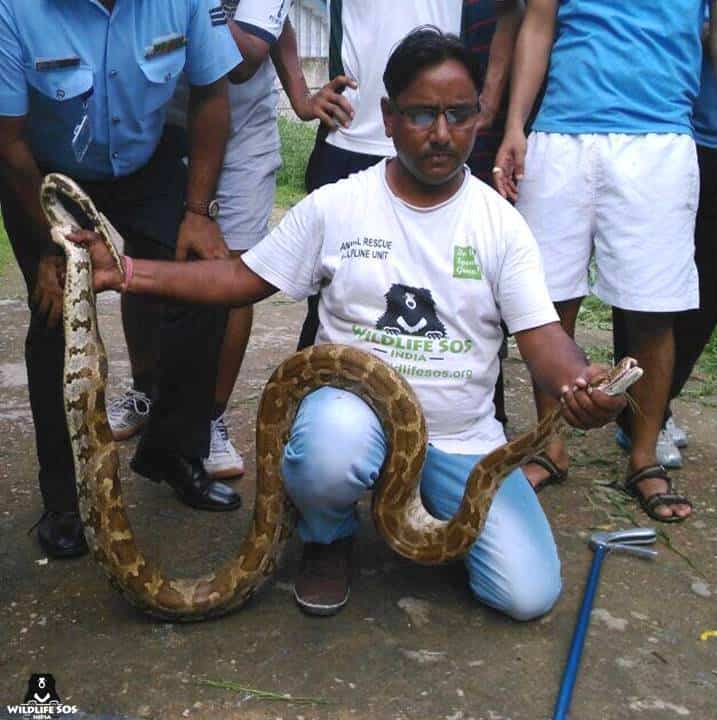The snake, along with other reptiles, is the most unwelcome guest you could find in your home. But wildlife lovers urge you to rescue it, not kill it, for it is usually not poisonous
Monsoon TIME is a time for snakes, even in Dellhi. As their underground homes get flooded with water, they slither out into the city. Just the other day, one was found in Delhi’s Vidhan Sabha. Then a common sand boa, small enough to be coiled in the palm of your hand, was rescued from a residential complex.
So if you encounter a snake, do not start beating it with sticks. “Just make sure that it stays where it is till the rescue team arrives,” explains Kadambari Atri, Head of Communications, Wildlife SOS. “Most times, the snake will just coil and hide in a corner. They are shy and fear humans.”
Baiju Raj MV, Director of Conservation Projects, Wildlife SOS, has other reassuring words. “Most species are non-venomous. In India, there are four venomous species known as the Big Four. These are the king cobra, krait, saw-scaled viper and Russell’s viper. Despite what’s shown in the movies, snakes only bite when they feel threatened,” he says.
Over 3,400 species have been identified across the globe. And around 270 are found in India.
On the occasion of World Snake Day (July 16), the Conservation Education Centre, run by Bombay Natural History Society at Asola Bhatti Wildlife Sanctuary in Delhi, organised an awareness workshop in association with the NGO Wildlife SOS.
Silent Captives
Snakes have also been a source of livelihood for snake charmers across the country. “They capture the snake and stitch their mouths and the starved snake dies within a month. Then more are captured,” says Atri.
The snake charmers take out the fangs and the venom, which is the snake’s digestive juice. Hence, the snake can’t eat or digest food. “Our rescuers have had to slowly take out all the stitches from the mouths. Obviously, the snake is starved and will eat anything that comes its way, including milk. But a snake is carnivorous and eats rodents, frogs, insects.”
Breaking some myths about the dance of the snake to the been, she adds that snakes have sensors. These get activated with the sound and the snake moves to see what is there.
“Many tribals and poor people are still earning through animals. We worked with snake charmers in Uttar Pradesh and have rehabilitated them with other skills, some have even joined our rescue team,” says Baiju. It does take years and years of study to know which species is venomous and which is non-venomous, but awareness camps aid in allaying fears and immediate reactions.
Wildlife SOS has rescued over a thousand reptiles till now which includes snakes, crocodiles, lizards. “We have found snakes hiding under motorcycles and in garbage bins.”The rescued snake is checked by the vet. If ill or hurt, it is treated and then released in its tural habitat. Wildlife experts say that the laws for wildlife protection are good but enforcement needs to be stronger. “The snake does not cry when it is hit. It is a silent creature,” sighs Baiju who loves snakes as his father was a herpetologist. “I have been around snakes since childhood and even helped my father.”
Fact & Fiction
“Nature has its own way of creating a balance. Snakes and lizards make their homes in termite mounts because they are meant to protect the queen. She has 98% protein and is often sold for Rs 4,000-5,000 in the market. But when a poacher breaks a termite mount, a snake acts as a deterrent,” informs Ishtiyak Ahmed, Education Officer Asola Bhatti Wildlife Sanctuary.
Snakes live on rodents, frogs and insects. The bigger ones eat pigs, small deer, even monkeys. “Rats can cause allergies, serious diseases and being food for the snakes, their population comes under check,” elucidates Baiju.
When the snake comes out of hibernation, it sits in the sun only long enough to warm up and hunt. Around 16 varieties of snakes have been identified in the Asola Bhatti Wildlife Sanctuary.
Anti-venom is available at all government hospitals and this is made from venom itself. “It doesn’t matter which species has bitten you, the medicine can take care of that. One should try and reach the hospital within 30 minutes of being bitten,” says Baiju.
So live and let live is the principle for this fascinating, slithery, silent creature.





